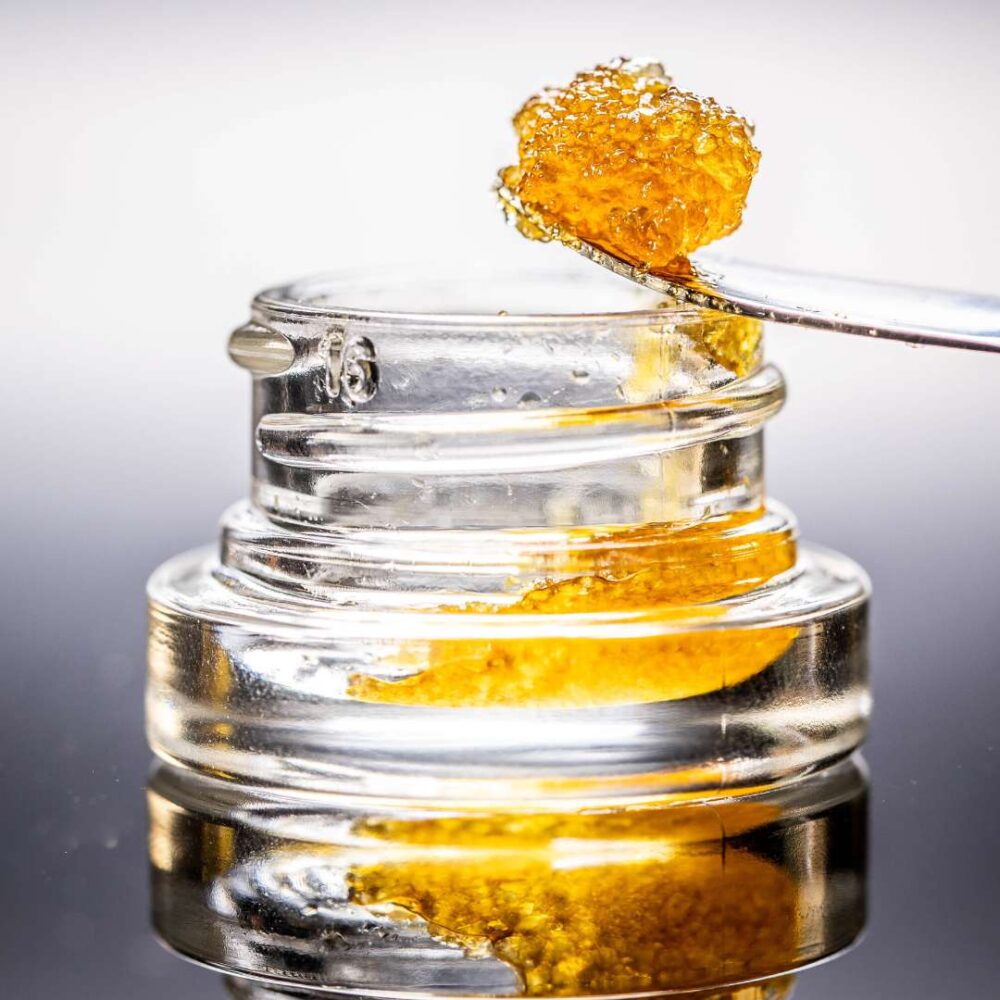
Live resin with Delta 8 is a popular product for many cannabis connoisseurs. It is considered one of the higher quality cannabis concentrates, but how does it actually differ from other quality concentrates?
Adding Delta 8 THC to live resin is a great way to get the recreational effects of Delta 8 with all the positive health benefits of a full cannabis extract.
However, is delta 8 live resin worth the extra cost, and what makes it special? We break down how live resin is made, what is in live resin sauce, and how adding Delta 8 may make it a great product.
Article Highlights
- Live resin is unique in its freezing process of raw hemp or marijuana flower that avoids the curing process.
- Increased amounts of terpenes are typically associated with live resin products.
- There may not be much of a difference between live resin products and high quality cannabis concentrates with added terpenes.
- Delta 8 live resin combines the recreational and relaxing effects of this minor cannabinoid with the full spectrum cannabinoid and terpene profile from the cannabis plant.
What is live resin?
Live resin is often associated with its increased amounts of terpenes and and full spectrum cannabinoids. Within the cannabis space, a live resin product is mostly defined by how the initial flower is harvested and stored, and not so much by the compounds in it.
Many cannabis consumers and aficionados will say that live resin is an oil that is closest to what is found in the natural cannabis flower. Is this true?
Sometimes, but usually not. Depends on what you buy.
What is in the natural cannabis flower?
The most well known and studied compounds in the cannabis flower are the cannabinoids and terpenes. If you extract and isolate cannabinoids intact, then you will have an acidic cannabinoid profile. This natural extract will be high in either CBDA or THCA, and contain many other minor acidic cannabinoids, of which there are over 100.
Depending on the producer, most live resin products do not have CBDA or THCA, but are focused on CBD and THC, the decarboxylated forms created during the purification process.
For live resin products, you should find a good amount of terpenes, since they are found in relative abundance in most hemp and marijuana flowers. These products should have a full terpene profile, which are typically collected during purification and added back to the cannabinoid oil at the end.
Is there a difference between live resin and other cannabis concentrates
The main difference is the amount of terpenes in the product, and sometimes, a small improvement in the full cannabinoid profile. Unless the live resin also has acidic cannabinoids, there is not much difference to speak of.
What about live resin and live rosin?
Live rosin is usually a very different product where the cannabis flower is mixed aggressively in ice cold water to separate out the trichomes from the rest of the plant. This is followed by a low heat pressure extraction process that essentially squeezes out the oil from the trichomes.
Live rosin presses should yield a quality acidic cannabinoid profile with good levels of terpenes. Because of the initial trichome isolation, you dont have to use traditional purification methods that require a heating mechanism.
However, the downside of a live rosin press method is it is very inefficient. A company will only get between 10-30% of all the cannabinoids out of the cannabis flower.
The main difference between live resin and live rosin is that live resin is often decarboxylated and has to add the terpenes back in.
What are terpenes?
Terpenes are class of compounds that are found in almost all plants you look at. Different plants have different amounts of terpenes and kinds of terpenes.For example, many citrus fruits are high in limonene, the terpene that gives lemons their unique smell. And pine needles are high in pinene, which give them their unique odor.
Terpenes are now a widely studied class of compounds for their health benefits. These include a range of effects, such as antioxidant, mental relaxation, and cardiovascular benefits.
What are some of the most common terpenes found in the cannabis plant?
- beta-Myrcene
- alpha/beta-pinene
- beta-Caryophyllene
- Limonene
- Terpinolene
Live resin production process
The live resin production process does not cure the hemp flower, but instead freezes the fresh cannabis for later extraction. This differs from the normal process of harvesting the flower for the drying and curing process which prevents growth of mold and bacteria on the bud.
Why does this make a difference between live resin extraction process and normal cannabis concentrate processes? The terpenes are better preserved when you immediately freeze the hemp or marijuana flower right after harvest.
What is live resin extraction process
Live resin frozen plant material is extracted using propane/butane under freezing temperatures.
- Frozen cannabis is placed in a large vessel that is also at a sub-zero temperature.
- Liquid propane/butane at freezing temperatures are released quickly into the vessel and pass over the frozen cannabis.
- The crude extract is collected, and the propane/butane vaporized off the extract.
- The extract contains all the acidic cannabinoids (eg CBDA/THCA) and terpenes that are natural flavors of the cannabis plant. However, this crude extract is typically in the 60-70% purity range, and requires further processing.
- The crude extract is put into a short path distillation apparatus (or something similar), and then heated under vacuum. The terpenes are collected first, and then the cannabinoids are decarboxylated when boiled off second.
- After multiple runs, the terpenes and decarboxylated cannabinoids (eg CBD/THC) are recombined into a final product.
Can you tell the difference?
During a normal drying and curing process, many of the terpenes are lost because they are a volatile compound that gets release into the air. However, many producers of normal cannabis products will just add back the terpenes into their final product to compensate.In fact, during the short path distillation process used by the industry, including live resin producers, the terpenes are boiled off first, and then added back at the end.
Note: most consumers would not be able to tell the difference between live resin and a high quality concentrate with added terpenes.
What is delta 8 THC?
Delta 8 THC is a minor cannabinoid found in cannabis plants, and has largely been forgotten by the cannabis world due to its very low abundance. This compound is known as "THC light", since it has euphoric and recreational effects, but is much less potent than the more common Delta 9 THC.
With the passing of the 2018 Federal Farm Bill, the law specifically outlawed any Delta9 THC from hemp over 0.3%. But this left the door open to other cannabinoids that had similar effects, but were not Delta 9 THC.
Now, most Delta 8 THC is produced by converting CBD in test tube and then adding it back into a final product. This is done because the federal farm bill stipulates that cannabinoids from hemp are legal.
Note: Whenever you buy Delta 8 THC products, it is very important to check that the supplier has a certificate of analysis (CoA) by a third party lab. They should be testing for residual solvents and all cannabinoids to make sure nothing is left over from the conversion process.
Benefits of delta 8 live resin
Many consumers use Delta 8 THC for its relaxing properties and its help with pain, but also want to get the health benefits of the whole cannabis plant. In this case, you can have your cake and eat it too.
Delta 8 THC can be used for both its relaxing effects, which many consumers use for help with pain and sleep, but also its recreational effects at higher doses. Adding Delta 8 to live resin helps to balance out the effects of Delta 8 THC and improves the other benefits of cannabinoids and terpenes.
This unique blend creates an "entourage effect" with all the combined cannabinoids and terpenes, maximizing the health benefits.
How to use delta 8 live resin
This popular live resin product is often used in two main ways, edibles and tinctures or with a vape pen. Both are a great way to enjoy the benefits of delta 8 live resin.
- Live resin vape pen: These are formulated by combing the live resin and Delta 8 THC into a concentrate, and then mixing it with propylene glycol or vegetable glycerin. These additives make it slightly more easy to vape, and give it those big smoke looks. However, some companies also offer a more pure form without the additives, and these typically contain a higher amount of terpenes to decrease the viscosity of the mixture.
- Live resin tinctures: These are made by mixing MCT oil or hemp seed oil with the live resin and Delta 8 THC. While not as rapid as using a vape pen, you still get all the benefits without the smoke.
- Live resin edibles: You may see these in gummies, brownies, or other foods. You will get the effects of Delta 8 THC and other cannabinoids, but they are not as well absorbed as vaping or using tincture under the tongue.
What is the right dose for Delta 8 live resin?
Cannabis users are rightly focused on what the ideal dose should be, since everyone experiences cannabinoids a little differently. The dose that works best for you should be top of mind when using any product that contains THC.
Consumers who are new to Delta 8 THC would benefits from starting with a low dose, typically around 5mg or under. This can be difficult since many Delta 8 products have much higher amounts, but you can always cut the edible down in size, or take a lower amount of tincture.
Note: A vape pen makes is harder to dose properly, so if you go this route, make sure to start slowly if new.
Note: Unless you are vaping, Delta 8 edibles can take up to an hour to kick in, so moderate your intake before consuming more!
Always start with a lower dose if you have a new product, and check for a third party test (CoA) before buying.
Does live resin cost more?
It is not uncommon for live resin products to cost a bit more than other cannabis concentrates, and this is due to a slightly higher cost associated with capturing and storing uncured cannabis plants.



